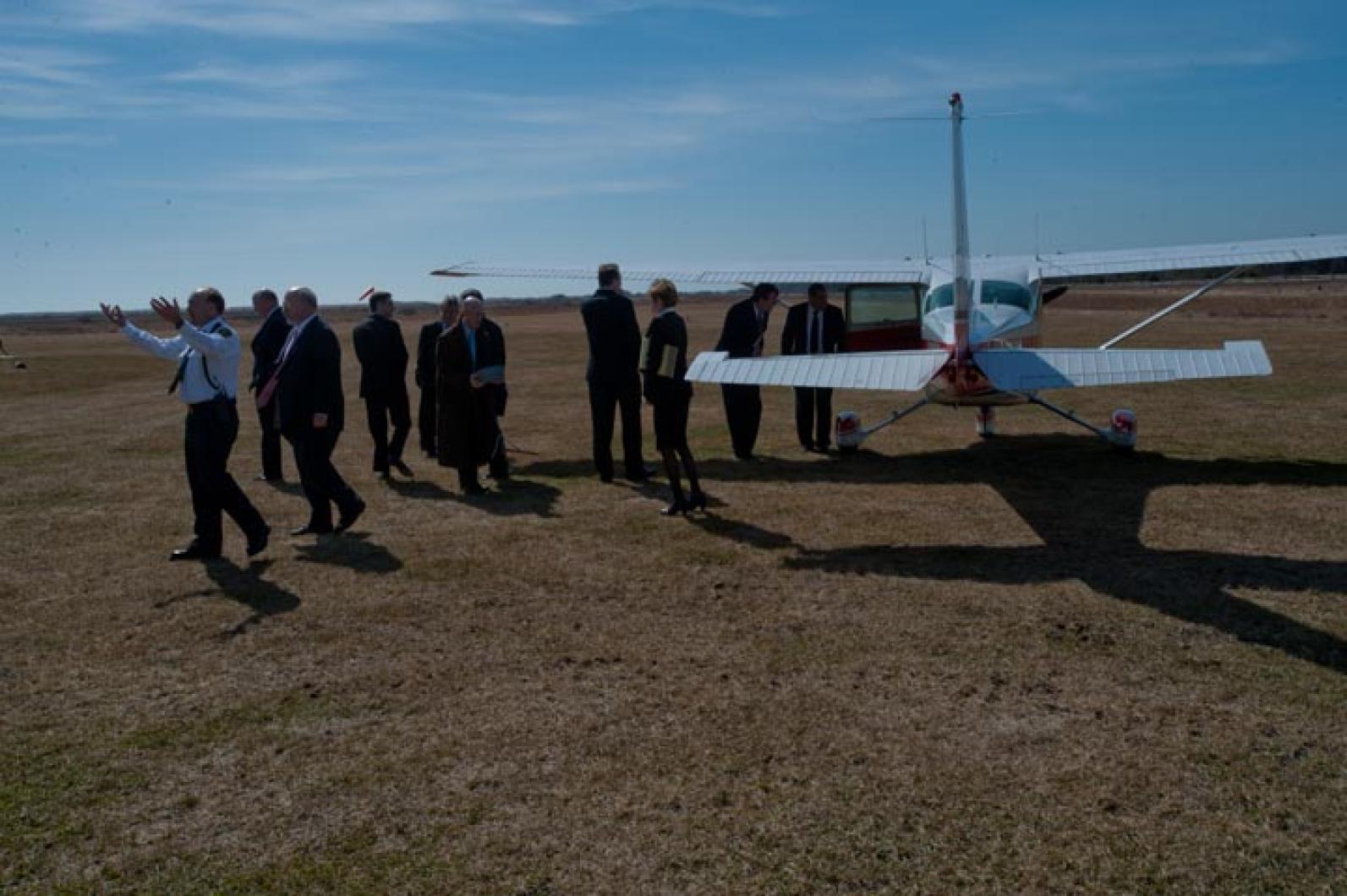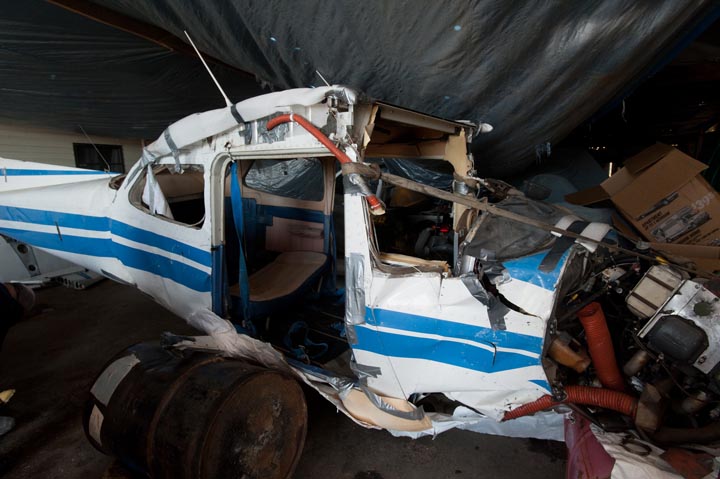The legal saga of Alec Naiman, Jeffrey Willoughby and Jessica Willoughby vs. Cessna Aircraft Company ended abruptly this week, after the three 2005 plane crash victims accepted settlement offers.
The nearly month-long Edgartown trial concluded Wednesday when Mr. Naiman, the pilot who suffered crippling injuries in the crash at Katama airfield, agreed to a confidential settlement. Last Friday, the Willoughbys — who were passengers in the plane — dropped out of the case after they agreed to a $1.7 million settlement offer from Cessna, according to their lawyer, David Angueira.
On the eve of closing arguments and jury deliberations, lawyers huddled during a sidebar with Dukes county superior court Judge Cornelius Moriarty 2nd and with Mr. Naiman, 57, the pilot of the Cessna 172-N plane that crashed on June 23, 2005.
When they emerged, the case was over. There was no formal announcement, but Donald J. Nolan, one of Mr. Naiman’s lawyers, and Ralph G. Wellington, an attorney for Cessna, confirmed that the case had been settled.
Asked about Mr. Naiman’s response to the settlement, Mr. Nolan said later: “I’ve never represented a person as injured as Alec Naiman who would prefer a settlement to the healthier days of his life.”
Mr. Naiman and his two passengers sued Cessna in 2008, alleging a breach of implied warranty involving aluminum rails on the cockpit floor that are a critical component in locking the pilot’s seat into place. Instead, they alleged, the seat slipped along the rails during an aborted landing, triggering a series of actions that stalled the plane and ultimately sent it, nose down and right wing aloft, into Katama’s grass field.
Cessna countered that the case was simple: The pilot’s own errors and inexperience caused the crash.
Mr. Naiman, confined to a wheelchair since the crash, and the father and daughter passengers were participating in a Deaf Pilots Association “fly-in” in which about 10 planes headed to Katama from Plymouth on a sunny day. He and his two passengers are deaf.
The trial featured an unusual courtroom tableau: a rotation of interpreters translating court proceedings into sign language for the three plaintiffs and, in turn, Mr. Naiman’s and the Willoughbys’ testimony into audible responses for the lawyers, jurors and the judge.
The trial’s presence in Edgartown began at the end of February, as hundreds of potential jurors were called to the courthouse to begin jury selection. A jury of 14 was eventually impaneled, though two jurors were excused along the way for illness. In the end, a jury of 12 — nine women and three men — heard 16 days of testimony in the case.
For the past four weeks, Edgartown pedestrians and motorists also encountered a curious ritual on Main street each weekday: a court officer leading the jurors from the Dukes County Courthouse across the street into town hall, where the trial was conducted. The first-floor selectmen’s hearing room allowed easier access for Mr. Naiman and helped avoid creating a space crunch at the busy courthouse.
Seasoned trial lawyers from Chicago, Philadelphia and Boston — a total of a dozen attorneys and legal staff—battled in the cramped, makeshift courtroom, and their arguments and examination of witnesses sometimes morphed into courtroom theatrics that kept Judge Moriarty. He did not hesitate to scold lawyers and witnesses when he felt they crossed the line. On the other hand, the court occasionally displayed Island hospitality. Superior court clerk Joseph E. Sollitto 2nd gave both sides boxes of Chilmark chocolates.
On Tuesday, the trial’s visible presence in Edgartown included a Cessna 172-N cockpit, an exemplar plane with the wings, engine, and tail removed, which was set up on a patch of grass by town hall. As onlookers gawked and took pictures, the trial’s participants — Judge Moriarity in his robe, the court reporter taking notes, the jury, lawyers, and sign language translators — watched as an expert pointed out parts of the plane.
The jury heard from dozens of witnesses whose testimony ranged from the dry and technical — the metallurgic properties of aircraft parts, for example, and the aerodynamics of a distressed aircraft — to riveting descriptions from crash victims and first responders who pulled them from the wreckage.
At the end of the trial, lawyers praised the judge and jury for their careful attention to the case. “All the parties wanted to thank the citizens of Martha’s Vineyard, especially the jurors who were attentive and devoted,” said Thomas P. Routh, a lawyer for Mr. Naiman, as lawyers and court personnel prepared to leave the courtroom late Wednesday afternoon. On Thursday morning, Judge Moriarty met privately with the jurors to thank them for their service and answer questions about the case.
At the heart of the case was whether Mr. Naiman’s seat unexpectedly slid backwards as he struggled to perform a “go around” maneuver after he spotted a plane at or near the intersection of two runways as he descended at Katama Airfield. The insurance company for the biplane pilot and Classic Aviators, the company that owns the bi-plane settled claims with the plaintiffs earlier, according to Mr. Angueira.
Days of testimony were spent in which defense and plaintiffs’ experts provided widely disparate views about whether the seat-locking system failed at a critical moment and whether Cessna had ignored the problems or, at least, failed to adequately install a safer system that would prevent “seat slippage,” as it was occasionally called.
Several times, jurors were shown a 10-second video of the plane crash, which was taken by an onlooker. The plaintiffs argued that the video showed Mr. Naiman attempting a go-around without being in control of the plane, because of the seat slip, while defense experts said the video showed the pilot was in control of the plane, which stalled during an improper go-around maneuver.
Cessna experts testified that the system was sound, even though the company produced backup systems in the late 1980s and 2007.
The key component, aluminum rails into which stainless steel pins were meant to lock, had been replaced in Mr. Naiman’s plane, which was built in 1979 and owned by the Paramus Flying Club, in 2002. After the crash, testimony indicated, the seat was found locked into the fifth holes along the rails, with Cessna suggesting those were approximately the same location Mr. Naiman’s seat would normally be located.
One of the most compelling — and critical — witnesses was Miss Willoughby. Now 19 and a student at Gallaudet University, she had turned 13 a few weeks before crash.
On June 23, she rode on a bench seat behind Mr. Naiman and her father, a student pilot, and had the most vivid memory of the moments before the crash. [Her father said he blacked out and Mr. Naiman said he suffered a brain injury that erased his memories of the events leading to the crash.]
She testified that Mr. Naiman’s seat suddenly slid back onto her legs or ankles as the plane was descending, causing her pain. Moments later, the plane crashed and she said the pain was “100 times” worse. “It was very painful and I’ll never forget how it felt. I couldn’t move my legs, and the first thing I thought was, I’ll never move again,” she testified.
On the ground, she described a horrific scene in which she was covered with blood, and fuel from a severed line was spilling all over her. All three were safely removed from the aircraft, but each still suffers from injuries, with Mr. Naiman the most seriously injured.
Last Friday morning, Miss Willoughby and her father were suddenly absent from the courtroom. “The plaintiffs Jeffrey and Jessica Willoughby are no longer part of this case and you may not speculate as to the reasons why,” Judge Moriarty told the jury. Their lawyer, Mr. Angueira, and Cessna attorneys had negotiated a settlement, the terms of which he disclosed this week, after Mr. Naiman’s case concluded.
He said the Willoughbys had been fairly compensated for their ordeal. “This is the end of a traumatic experience for them at the expense of Cessna,” he said in a phone interview. “They have been struggling and fighting with Cessna for years.”
It’s unclear what drove Mr. Naiman and Cessna towards a settlement Wednesday. By mutual consent, neither of the parties would address the agreement.
Mr. Naiman’s and the Willoughbys’ legal claims were launched in 2008, reaching federal trial courts in Boston and St. Louis, Mo., as well as Dukes Superior Court. Not only had Mr. Naiman sued Cessna, but a long line of others, including the town of Edgartown; the Katama airfield; Michael Creato, the airfield’s manager; Paul Santopietro, the pilot of a red biplane Mr. Naiman spotted on the ground; Classic Aviators, for whom Mr. Santopietro flew; the Paramus Flying Club, which owned the plane Mr. Naiman flew that day; and the Deaf Pilots Association itself.
In the meantime, the Willoughbys sought damages from most of the same parties, and initially sued Mr. Naiman in their federal lawsuit in Missouri. They settled with him and the Paramus Flying Club for about $100,000 each in October 2008, Mr. Angueira said.
All the litigation came down to the Dukes County Superior Court cases, with Mr. Naiman and the Willoughbys facing off against Cessna, as all other claims against the various defendants were either settled or dismissed.
And then there were two, as Mr. Naiman and the Wichita, Kan.-based aircraft manufacturer were the only litigants remaining this week. And on Wednesday afternoon, without warning to the jurors, who had been dismissed for the day and expected to begin deliberations late Thursday, Mr. Naiman and Cessna reached an agreement rather than take their chances with the jury.
In his wheelchair, Mr. Naiman received hugs from his lawyers and handshakes from Cessna’s lawyers. And then, Mr. Naiman, an associate professor of American sign language and deaf culture at Nassau Community College in Garden City, N.Y., turned his wheelchair towards the judge.
“He has something to say,” his sign language interpreter said.
“Thank you,” she said, translating for Mr. Naiman.
“Good luck,” the judge was overhead saying.








Comments
Comment policy »